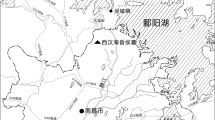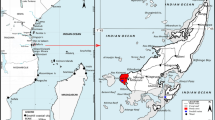Abstract
Archaeological sites in the territory of Tuva possibly related to the Xiongnu culture include the burial sites of Bay-Dag 2, Aymyrlyg-XXXI, Urbiun-III, and the recently discovered burial sites of Terezin and Ala-Tey, all located in the Ulug-Khem (Yenisei) River basin, at the entrance to the Sayan canyon of Yenisei. This critical location marks the start of the route to the Minusinsk Hollow through the Sayan Mountains and possesses the largest and best grazing areas in Central Tuva. About 50 flat graves of the Xiongnu period have been excavated at Ala-Tey and Terezin: burial types include stone cists and pits faced with stone or wood. Burial positions were mainly stretched, supine but several burials feature flexed legs. Each grave contained either one or two ceramic vessels. Unlike Ala-Tey, at Terezin, weaponry was found, namely, a bone bow strengthener and an arrowhead. Burials at both sites include many decorations for belts and clothing, beads, pendants, earrings, Chinese wu zhu coins, and Western Han mirrors and their fragments. The openwork bronze belt plaques represent true masterpieces of ancient nomadic art. Artifact types and AMS dates suggest these sites may date to the second-first centuries BC.



















Similar content being viewed by others
References
Alekseeva, E. M. (Алексеева Е. М.) (1978). Античные бусы Северного Причерноморья (Ancient beads from the northern Black Sea Coast). Cвод археологических источников – САИ (Corpus of archaeological sources) Г1–12, vol. 2.
Bogdanov, E. S. (Богданов Е. С.) (2006). Образ хищника в пластическом искусстве кочевых народов Центральной Азии (скифо-сибирская художественная традиция) (The image of predator in the plastic art of nomadic peoples of Central Asia (Scythian-Siberian artistic tradition). Novosibirsk: IAE SO RAN.
Brosseder, Ursula (2011). “Belt plaques as an indicator of East—West relations in the Eurasian Steppe at the turn of the millennia.” In Ursula Brosseder and Bryan K. Miller (eds.), Xiongnu Archaeology: Multidisciplinary Perspectives of the First Steppe Empire in Inner Asia. Bonn Contributions to Asian Archaeology 5, pp. 349–424. Bonn: Institut für Vor- und Frühgeschichtliche Archäologie, Rheinische Friedrich-Wilhelms-Universität.
Bunker, Emma C. 2002. Nomadic art of the eastern Eurasian steppes: The Eugene V. Thaw and other New York collections. Metropolitan Museum of Art: New York.
Davydova, A. V. (Давыдова А. В.) (1995). Иволгинский археологический комплекс. Том.1. Иволгинское городище (The Ivolga Archaeological Complex. Vol. 1. Ivolga fortified settlement). St. Petersburg: Asiatika.
Davydova, A. V. (Давыдова А. В.) (1996). Иволгинский археологический комплекс. Том.2. Иволгинский могильник (The Ivolga Archaeological Complex. Vol. 2. Ivolga cemetery). St. Petersburg: Asiatika.
Davydova, A. V. (Давыдова А. В.) and S. S. Minyaev (С. С. Миняев) (2008). Художественная бронза сюнну (Xiongnu decorative bronzes). St. Petersburg: GAMAS.
Devlet, M. A. (Дэвлет М. А.) (1980). Сибирские поясные пластины II в. до н.э.- I в. н.э (Siberian belt plaques II B.C. - I A.D.) / САИ; Д. 4–7. Moscow: Nauka.
Erdy, M. (2003–2004). “Art objects from the Sidorovka Kurgan cemetery and the analysis of its ethnic affiliation.” Siberian Association of Prehistoric Art Researchers Bulletin 6–7: 48–52. Kemerovo.
Eregzen, Gelegdorj, ed. 2011. Treasures of the Xiongnu. Culture of Xiongnu, the first nomadic empire in Mongolia. Ulaanbaatar: National Museum of Mongolia.
Grach, A. D. (Грач А. Д.) (1971). “Новые данные о древней истории Тувы. (New data on the ancient history of Tuva).” Ученые записки ТНИИЯЛИ (Scientific transactions of the Tuva Scientific Research Institute of History, Language and Literature): 15: 93–107. Kyzyl.
Kharinskiy, A. V. (Харинский А. В.) and A. M. Korostelev (Коростелев А. М.) (2011). “Западное побережье оз. Байкал в хуннское время (по материалам могильника Цаган Хушун) (The western shore of Lake Baikal in the Xiongnu time. Cemetery of Tsagan Hushun) - II.” In Хунну: археология, происхождение культуры, этническая история (Xiongnu: archaeology, origin of culture, ethnic history), pp. 173–202. Ulan-Ude: BNC SO RAN.
Khavrin, S. V. (Хаврин С. В.) (2016). Метал эпохи Хунну могильника Терезин I (Тува) (Metal of the Xiongnu period from the cemetery of Terezin [Tuva]). Археологические вести (Archeological News) 22 (2016): 105–107. St. Petersburg.
Khudyakov, U. S. (Худяков Ю. С.), S. V. Alkin (С. В. Алкин), and Yui Su-hua (Юй Су Хуа) (1999). “Сяньби и Южная Сибирь (Xianbei and South Siberia).” Древности Алтая (Antiquities of Altai) 4: 162–169. Gorno-Altaysk.
Konovalov, P. B. (Коновалов П. Б.) (2008). Усыпальница хуннского князя в Суджи. Ильмовая падь, Забайкалье (A burial vault of a Xiongnu prince at Sudzha (Il’movaya Pad’, Transbaikalia). Ulan-Ude: BNC SO RAN.
Kost, Catrin (2014). The Practice of Imagery in the Northern Chinese Steppe (5th-1st Centuries BCE). Bonn Contributions To Asian Archaeology 6. Bonn: Institut für Vor- und Frühgeschichtliche Archäologie, Rheinische Friedrich-Wilhelms-Universität.
Kuzmin, N. Y. (Кузьмин Н. Ю.) (2011). Погребальные памятники хунно-сяньбийского времени в степях Среднего Енисея. Тесинская культура. (Burial sites of the xiongnu-xianbei period in the steppes of Middle Yenisey. The Tes-Culture). St. Petersburg.
Lankton, James W. 2003. A bead timeline, Vol. I: Prehistory to 1200 CE. Washington, D.C.: Bead Society of Greater Washington.
Leus, Pavel M. (Леус П. М.) (2008). Терезин – новый памятник гунно-сарматского времени в Центральной Туве (предварительное сообщение) (Terezin – A new Xiongnu period site in Central Tuva). Труды II (XVIII) всероссийского археологического съезда в Суздале, Том II (Transactions of the II nd All-Russian Congress in Suzdal, Vol II). Moscow: IA RAN.
Leus, Pavel M. (2011). “New finds from the Xiongnu period in Central Tuva.” Xiongnu Archaeology: Multidisciplinary Perspectives of the First Steppe Empire in Inner Asia. Bonn Contributions to Asian Archaeology 5, pp. 515–536. Bonn: Institut für Vor- und Frühgeschichtliche Archäologie, Rheinische Friedrich-Wilhelms-Universität.
Leus, Pavel M. (Леус П. М.) and S. V. Bel’skiy (С. В. Бельский) (2016). Терезин I – могильник эпохи хунну в Центральной Туве (Terezin 1 – A burial ground of the Xiongnu time in Central Tuva). Археологические вести (Archeological news) 22 (2016): 93–104. St. Petersburg.
Linduff K. (1997) An archaeological overview. In Bunker, E (ed.), Ancient bronzes of the eastern Eurasian steppes from the Arthur M. Sackler collections. New York.
Lubo-Lesnichenko, E. I. (Лубо-Лесниченко Е. И.) (1975). Привозные зеркала Минусинской котловины (Imported mirrors in the Minusinsk Hollow). Moscow: Nauka.
Mandel’shtam, A. M. (Мандельштам А. М.) and E. U. Stambul’nik (Э. У. Стамбульник) (1992). Гунно-сарматский период на территории Тувы (Hun-Sarmatian period in the territory of Tuva). In M. G. Moshkova (editor), Степная полоса Азиатской части СССР в Скифо-сарматское время (The Steppe Zone of the Asiatic part of the USSR during the Scythian-Sarmatian period), pp. 196–205. Moscow: Nauka.
Matiushchenko, V. I. (Матющенко В. И.), and L. V. Tataurova (Л.В. Татаурова) (1997). Могильник Сидоровка в Омском Прииртышье (Sidorovka cemetery on the Irtysh near Omsk). Novosibirsk: Nauka.
Miller, Bryan K., Zhansranzhav Baiarsaikhan, Tseveendorzh Egiimaa, Prokopii B. Konovalov, and Judith Logan (2009a). “Elite Xiongnu burials at the periphery: tomb complexes at Takhfigtyn Khotgor, Mongolian Altai.” In Jan Bemmann (editor), Current Archaeological Research in Mongolia, vol. 4, pp. 301–314. Bonn: Vor- und Frühgeschichtliche Archäologie Rheinische Friedrich-Wilhelms-Universität.
Miller, Bryan K., Zhansranzhav Baiarsaikhan, Tseveendorzh Egiimaa, Prokopii B. Konovalov, Judith Logan, and M. Machicek. 2009b. Xiongnu constituents of the high mountains: Results of the Mongol-American Khovd archaeology project, 2008. The Silk Road 7: 8–20.
Minyaev, S. S. (Миняев С. С.) (2007). Дырестуйский могильник (Dyrestuj burial ground). St. Petersburg: St.Petersburg State University.
Nikolaev, N. N. (Николаев Н. Н.) (2003). Планиграфия могильника Бай-Даг II (Plan of Bay-Dag-Ii cemetery). Степи Евразии в древности и средневековье. Книга II. Материалы научно-практической конференции, посвящённой 100-летию со дня рождения М.П. Грязнова (Steppe of Eurasia in ancient and medieval time), pp. 260–262. St. Petersburg: IIMK RAN.
Pan, Ling (2011). “Summary of Xiongnu sites in northern China.” Xiongnu Archaeology: Multidisciplinary Perspectives of the First Steppe Empire in Inner Asia. Bonn Contributions to Asian Archaeology 5, pp. 463–474. Bonn: Institut für Vor- und Frühgeschichtliche Archäologie, Rheinische Friedrich-Wilhelms-Universität.
Ramsey, Bronk, Christopher, and Sharen Lee. 2013. Recent and planned developments of the program OxCal. Radiocarbon 55 (2–3): 720–730.
Rawson, Jessica. 1995. Chinese jade from the Neolithic to the Qing. London: British Museum.
Rawson, Jessica, and Emma C. Bunker. 1990. Ancient Chinese and Ordos bronzes. Hong Kong: The Royal Asiatic Ceramic Society.
Reimer, Paula J., et al. 2013. IntCal13 and Marine13 radiocarbon age calibration curves 0–50,000 years cal BP. Radiocarbon 55 (4): 1869–1887.
Savinov, D. G. (Д. Г. Савинов) (1969). Погребение с бронзовой бляхой в Центральной Туве (Burial with a bronze plaque in Central Tuva). КСИА 119: 104–108. Moskva: Nauka.
Savinov, D. G. (Д. Г. Савинов) (2010). История открытия и проблемы изучения памятников Кокэльской культуры (History of the discovery and studies of the Kokel Culture). Памятники Кокэльской культуры Тувы: материалы и исследования. St. Petersburg: ElekSis.
Semenov, V. A. (Семёнов Вл. А.) (2003). Суглуг-Хем и Хайыракан. Могильники скифского времени в центрально-тувинской котловине. (Suglug-Khem and Khayrakan – burial sites of the Scythian period in the Central Tuva Hollow). St. Petersburg: Peterburgskoe Vostokovedenie.
Stambul’nik, E. U. (Стамбульник Э. У.) (1983). Новые памятники гунно-сарматского времени в Туве (некоторые итоги работ) (New sites of the Xiongnu-Sarmatian period in Tuva). Древние культуры евразийских степей (Ancient Cultures Of Eurasian Steppe), pp. 34–41. Leningrad: Nauka.
Tishkin, A. A. (Тишкин А. А) (2006). Китайские зеркала из памятников ранних кочевников Алтая (Chinese mirrors from the sites of early nomads of Altay) // Russia and the Pacific, Nr.4. Vladivostok.
Vadetskaya, E. B. (Вадецкая Э. Б.) (1999). Таштыкская эпоха в древней истории Сибири. (Tashtyk period in the ancient history of Siberia). St.Petersburg, (Archaeologica Petropolitana; VII).
Wagner, M., and H. Butz. 2007. Nomadenkunst: Ordosbronzen der Ostasiatischen Kunstsammlung. Archäologie in Eurasien 23. Mainz: Philipp von Zabern.
Author information
Authors and Affiliations
Corresponding author
Rights and permissions
About this article
Cite this article
Kilunovskaya, M., Leus, P. Archaeological discoveries in Tuva: excavations of the Ala-Tey and Terezin cemeteries of the Xiongnu period in 2015–2016. asian archaeol 1, 45–62 (2018). https://doi.org/10.1007/s41826-018-0004-5
Received:
Accepted:
Published:
Issue Date:
DOI: https://doi.org/10.1007/s41826-018-0004-5




